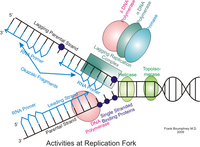
Photo from wikipedia
Abstract The replication of the genome is a highly organized process, both spatially and temporally. Although a lot is known on the composition of the basic replication machinery, how its… Click to show full abstract
Abstract The replication of the genome is a highly organized process, both spatially and temporally. Although a lot is known on the composition of the basic replication machinery, how its activity is regulated is mostly unknown. Several chromatin properties have been proposed as regulators, but a potential role of the nuclear DNA position remains unclear. We made use of the prominent structure and well-defined heterochromatic landscape of mouse pericentric chromosome domains as a well-studied example of late replicating constitutive heterochromatin. We established a method to manipulate its nuclear position and evaluated the effect on replication timing, DNA compaction and epigenetic composition. Using time-lapse microscopy, we observed that constitutive heterochromatin, known to replicate during late S-phase, was replicated in mid S-phase when repositioned to the nuclear periphery. Out-of-schedule replication resulted in deficient post-replicative maintenance of chromatin modifications, namely silencing marks. We propose that repositioned constitutive heterochromatin was activated in trans according to the domino model of origin firing by nearby (mid S) firing origins. In summary, our data provide, on the one hand, a novel approach to manipulate nuclear DNA position and, on the other hand, establish nuclear DNA position as a novel mechanism regulating DNA replication timing and epigenetic maintenance.
Journal Title: Nucleic Acids Research
Year Published: 2018
Link to full text (if available)
Share on Social Media: Sign Up to like & get
recommendations!